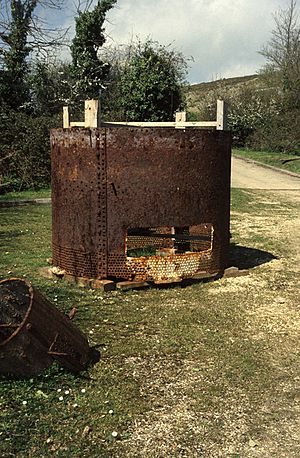River Jordan, Dorset facts for kids
Quick facts for kids Jordan |
|
|---|---|

The River Jordan near Preston
|
|
| Country | England |
| County | Dorset |
| Villages | Sutton Poyntz, Preston |
| Physical characteristics | |
| Main source | Spring Bottom Sutton Poyntz, Dorset, UK 45 m (148 ft) 50°39′34″N 2°24′54″W / 50.659471°N 2.415091°W |
| River mouth | Bowleaze Cove, Weymouth Bay Weymouth, Dorset, UK 0 m (0 ft) 50°38′11″N 2°25′16″W / 50.636371°N 2.421231°W |
| Length | 4.7 km (2.9 mi) |
| Basin features | |
| Basin size | 7.9 km2 (3.1 sq mi) |
The River Jordan is a small but interesting river in Dorset, England. It flows for about 3 miles (4.8 km) (or 4.7 kilometres (2.9 mi)) before joining the English Channel. This river gets its water from two smaller streams: the Osmington Brook and the Preston River. It finally reaches the sea at Bowleaze Cove, near Weymouth.
Contents
What's in a Name?
The name of the River Jordan is similar to the nearby Jordan Hill. It likely comes from old English words meaning "hill at the bend." So, "Jordan Hill" might actually mean "hill hill"!
The river is sometimes called the Preston River. This is because one of its main streams is named the Preston River.
The River's Journey
The River Jordan starts from two streams high up in the Dorset Downs. One stream, the Preston River, begins at a place called Spring Bottom. The other, the Osmington Brook, starts further east near Osmington. These streams get their water from springs that come out of the chalk hills.
Where the Streams Meet
The two streams flow into Sutton Poyntz village and join together. The northern part of the river used to power two corn mills here. One of these mills, Sutton Upper Mill, was even featured in a book by Thomas Hardy called The Trumpet-Major. The stream also forms the village duck pond, which was originally part of the mill's water channel.
After joining, the river flows south into Preston village. Here, there was once another corn mill. A bridge called Roman Bridge crosses the river downstream from the mill. Even though it's called "Roman," experts think it was built much later, after the Norman conquest of England.
The river then flows past Jordan Hill. It also cuts through the site of an old Roman villa. However, when the Romans built the villa, the river flowed in a different path. Finally, the River Jordan empties into Bowleaze Cove. This is a small beach on the famous Jurassic Coast, which is part of Weymouth Bay.
In the 1800s, a water company changed part of the river's path. They diverted some of the upstream water into pipes to help pump water for the town of Weymouth.
A Look Back in Time
People have lived near the River Jordan for a very long time. Evidence shows that people lived here during the Stone Age and Iron Age.
The Romans also built a villa right by the river. It was used until the third or fourth century AD. There was also a Roman temple nearby on Jordan Hill.
It's possible that mills used the river's power as early as the 800s. Records from 891 AD mention the village of Sutton, where the mills were. By 1086, a survey called the Domesday Book showed that 12 mills were working in the village!
The river even appears in a famous painting! John Constable painted Weymouth Bay: Bowleaze Cove and Jordon Hill in 1816–17. He was likely inspired during his honeymoon in Osmington. This painting is now in the National Gallery.

In 1856, a water company turned the old Upper Mill into a pumping station to supply water to Weymouth. After a famous ship, the SS Great Eastern, had an explosion in 1859, one of its giant funnels was bought by the water company. They used it in their water filter system! The funnel was removed in 2004 and given to the SS Great Britain Trust in Bristol.
Flooding Challenges
In the late 1900s and early 2000s, the River Jordan often flooded in Sutton Poyntz and Preston. Big floods happened in 1955, 1977, 1979, 1983, 1993, and 2003.
Because of this, the Environment Agency started a plan to stop the floods. They found that the floods were caused by:
- Mud building up in the river near Preston Mill.
- Water not flowing easily through bridge arches.
- Blocked underground pipes (culverts).
Heavy rain makes the flooding worse, especially when the Preston Brook carries a lot of water.

